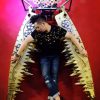
A magic show can be called a magic show if it presents something visually incredible. Getting people to watch this incredible phenomenon is to perform magic tricks. Although magic does not constitute a work in copyright law, it can ultimately constitute a trade secret and thus enjoy the protection of the Trade Secrets Law or the Anti-Unfair Competition Law.
During the magic show or magic tricks, the magicians mostly performance through a professional stage magic props or street magic props, so now let’s see how many categories of magic props in the maigican’s world.
Magic Props Categories:
1) From a historical perspective: Chinese magic can be divided into “ancient Chinese magic” and “modern magic”; it is often seen in some performances that someone is good at “classical tricks”, which is a type of ancient Chinese magic.
(2) According to principles and techniques: (This classification is not absolute, different principles and techniques can be cross-used according to different needs during performances)
Manipulative category – mainly based on technique, which must be practised diligently to perform.
Apparatus – performing with ingeniously designed organs and apparatus.
Psychological class – Magic performances are performed according to the principles of psychology.
Science and technology category—the performance is based on natural science knowledge such as chemistry and physics.
(3) Divided by props and scale: giant magic, medium magic, small magic
(4) According to the venue of the performance, it is divided into stage magic, banquet magic, street magic (also known as close-up magic)
(5) According to the theme of magic: A certain magician is good at magic with certain props and often performs magic with the same props together to form a special theme. Thematic magic includes coin magic, poker magic, escape magic, silk scarf magic, rope magic, sponge ball magic and so on.
(6) According to the magic effect:
Dariel Fitzkee, an American magician, once classified the effects of magic as follows in his book “The Trick Brain”:
1. Production—including emergence, manufacture, and reproduction (split). China Evoke Magic factory produces many kinds of such magic props, like body seven split, arm split, head split illusions, etc.

⒉ Disappear (Vanish) – to hide the solid form.

⒊Transposition – to hide the solid from one side to another side.
⒋ Change (Transformation) – qualitative and shape changes.

5. Penetration – the passage of one solid object through another solid object without injury.
 like this sward illusion box.
like this sward illusion box.
⒍ Restoration – to restore something completely destroyed.
⒎ Giving life (Animation) – making inanimate objects move by themselves.
⒏Floating (Antigravity) – change its gravity.
 like this levitation table.
like this levitation table.
⒐Attraction – the magical adsorption force, which also changes gravity, but there must be another tangible object to absorb.
⒑ Invulnerability ─ against the natural phenomenon of the human body.
⒒Physical Anomaly – Abnormal or deformed people or animals.
⒓Compete with the audience (Spectator Failure)─Ask the audience to come on stage and do the same, but the result will be different.
⒔ Sympathetic Reaction – Manipulating an object and causing another identical object to have the same reaction.
⒕ Control─Control inanimate objects with willpower.
⒖ Identification – identifying words or objects with senses other than vision.
⒗ Thought Reading – Read what the other person is thinking.
⒘Thought Transmission – Conveying your thoughts to others non-verbally.
⒙ Prophecy (Prediction) – predicting what will happen.
⒚ Extra Sensory Perception─commonly known as ESP.
If you want to find a good trustable supplier with abundant experience and professional work to buy quality magic props, here the Evoke Industries Co.,ltd is your best choice.
You can buy from present design, or make special design according to your fantanstic new magic ideas. Welcome to contact us to buy the best magic props here.




